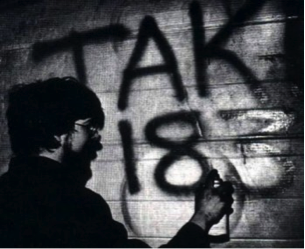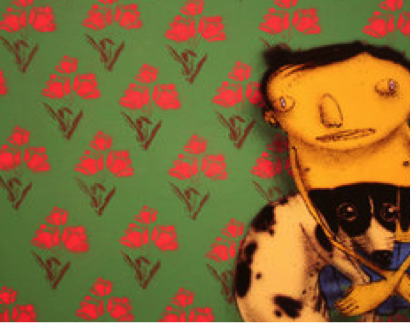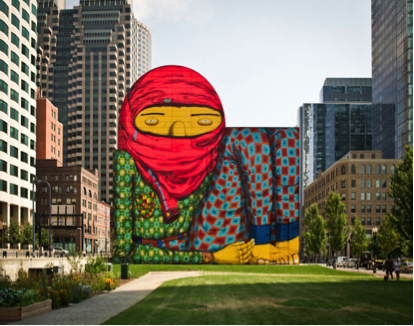Graffiti art as we know it today, began in the 70’s in New York and Philadelphia. The initial iterations were more concentrated in Philadelphia, especially with the two most popular graffiti artists at that time, Cornbread and Cool Earl, both were born in Philadelphia and focused their work there. [1]
Cornbread (original name Darryl McCray) is considered the “father of modern graffiti”, he started to do graffiti based upon his love interest for a girl andThis kind of expression is more trying to shock people, and for that he used different ways to depict his graffiti. [2]
Cornbread (original name Darryl McCray) is considered the “father of modern graffiti”, he started to do graffiti based upon his love interest for a girl andThis kind of expression is more trying to shock people, and for that he used different ways to depict his graffiti. [2]
| Imagem 01: Elephant graffiti, Philadelphya Zoo [2] | There are two “interventions” that he did and really caught people's attention, one was when he wrote his name on an elephant at the Philadelphia Zoo (image 03). He also wrote his name on the Jackson 5’s private jet which was actually a hoax as cornbread himself has admitted on camera. |
Cool Earl is also from Philadelphia and together with Cornbread started to do the first graffitis in the city. Both scrawled their names all over the city, and this was the kind of graffiti more common at those times. Around 1970 - 1971, the centre of graffiti innovation moved to New York City, and at Philadelphia, New York in the beginning letters were the most common pictures found, painted on buildings, post-boxes, phone boxes, underground tunnels, buses and finally on subway cars.. Graffiti artists like TAKI 183, JULIO 204 and CAT 161 became known for painting their tags (writer’s sign) on the walls and subways of the cities. [1]
Julio started the tag trend at New York, he wrote JULIO 204 on the streets, and he used his name and the number of the street where he lived, he could not write outside his neighborhood, due to him being in a gang. After, TAKI 183 did the same in the West Side of Manhattan. His given name is Demetrius, TAKI came from a Greek alternative for his birth-name. [3]
TAKI was last known to be the owner of a foreign car repair shop. In an interview with the New York Daily News of April 9, 1989, he talked about his retirement as a graffiti vandal: "As soon as I got into something more productive in my life, I stopped. Eventually I got into business, got married, bought a house, and had a kid. Didn't buy a station wagon, but I grew up, you could say that." He was the one that became more famous at that times; his name was spread in all over city: mailboxes, hallways, train stations, buses, inside and outside of subway cars. [3]
By 1973 the graffiti became a competition where who painted the most visible piece turned into a “king”, at this time each area had a king. The 80’s was the time when New York trains were covered by graffiti, then those pictures would be viewed all around the route. In 1986 the authorities took a stand to avoid or limit the range of the graffiti, subsequently, they started to build fences around the city’s properties and train stations.
During the 80’s and 90’s graffiti phenomenon spread, the graffiti artists started to travel around the world and because of those, “pieces” (abbreviation of masterpiece) started to appear almost all over Europe. At this point, graffiti was already something in large proportions and difficult to control. The punk movement helped graffiti to start early at Amsterdam and Madrid. However, hip hop was responsible to spread the graffiti throughout Western Europe and all Western influenced countries.
Later, Asia, South America, Africa and Australia would join the graffiti movement. However, the Graffiti and Street Art in those places was very underdeveloped at those times. Over the years, good works appeared and great artists began to be known around the world. One good example is the Brazilians Os Gemeos (The Twins), with their child-like design and social relevance.
TAKI was last known to be the owner of a foreign car repair shop. In an interview with the New York Daily News of April 9, 1989, he talked about his retirement as a graffiti vandal: "As soon as I got into something more productive in my life, I stopped. Eventually I got into business, got married, bought a house, and had a kid. Didn't buy a station wagon, but I grew up, you could say that." He was the one that became more famous at that times; his name was spread in all over city: mailboxes, hallways, train stations, buses, inside and outside of subway cars. [3]
By 1973 the graffiti became a competition where who painted the most visible piece turned into a “king”, at this time each area had a king. The 80’s was the time when New York trains were covered by graffiti, then those pictures would be viewed all around the route. In 1986 the authorities took a stand to avoid or limit the range of the graffiti, subsequently, they started to build fences around the city’s properties and train stations.
During the 80’s and 90’s graffiti phenomenon spread, the graffiti artists started to travel around the world and because of those, “pieces” (abbreviation of masterpiece) started to appear almost all over Europe. At this point, graffiti was already something in large proportions and difficult to control. The punk movement helped graffiti to start early at Amsterdam and Madrid. However, hip hop was responsible to spread the graffiti throughout Western Europe and all Western influenced countries.
Later, Asia, South America, Africa and Australia would join the graffiti movement. However, the Graffiti and Street Art in those places was very underdeveloped at those times. Over the years, good works appeared and great artists began to be known around the world. One good example is the Brazilians Os Gemeos (The Twins), with their child-like design and social relevance.
References
[1] Gallery Speerstra (2012). Retrieved June, 2013, from: http://www.speerstra.net/aboutgraffiti.php
[2] School Work Helper (2011), Retrieved June, 2013, from: http://schoolworkhelper.net/graffiti-art-history-material-tags
[3] Subway Outlaws (2011), Retrieved June, 2013, from:
http://www.subwayoutlaws.com/tag%20page2/TAG%20PAGE%2016.htm
[4] Tumblr (2011), Retrieved June 2013, from: http://www.tumblr.com/tagged/taki%20183
[5] Mondomix (2009), Retrieved June 2013, from: http://www.mondomix.com/news/graffiti-ne-dans-la-rue-expose-a-la-fondation-cartier
[1] Gallery Speerstra (2012). Retrieved June, 2013, from: http://www.speerstra.net/aboutgraffiti.php
[2] School Work Helper (2011), Retrieved June, 2013, from: http://schoolworkhelper.net/graffiti-art-history-material-tags
[3] Subway Outlaws (2011), Retrieved June, 2013, from:
http://www.subwayoutlaws.com/tag%20page2/TAG%20PAGE%2016.htm
[4] Tumblr (2011), Retrieved June 2013, from: http://www.tumblr.com/tagged/taki%20183
[5] Mondomix (2009), Retrieved June 2013, from: http://www.mondomix.com/news/graffiti-ne-dans-la-rue-expose-a-la-fondation-cartier





 RSS Feed
RSS Feed